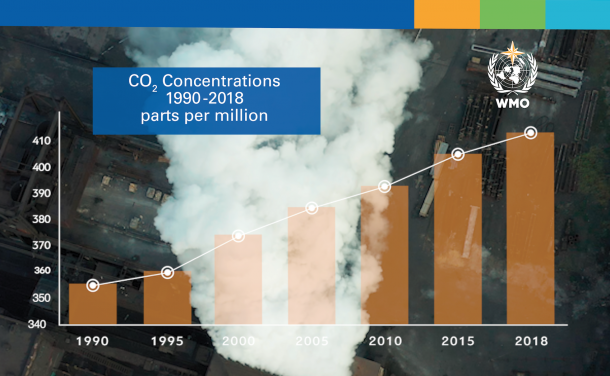
The WMO Greenhouse Gas Bulletin showed that globally averaged concentrations of carbon dioxide (CO2) reached 407.8 parts per million in 2018, up from 405.5 parts per million (ppm) in 2017.
The increase in CO2 from 2017 to 2018 was very close to that observed from 2016 to 2017 and just above the average over the last decade. Global levels of CO2 crossed the symbolic and significant 400 parts per million benchmark in 2015.
Concentrations of methane and nitrous oxide also surged by higher amounts than during the past decade, according to observations from the Global Atmosphere Watch network which includes stations in the remote Arctic, mountain areas and tropical islands.
Since 1990, there has been a 43% increase in total radiative forcing – the warming effect on the climate - by long-lived greenhouse gases. CO2 accounts for about 80% of this, according to figures from the US National Oceanic and Atmospheric Administration quoted in the WMO Bulletin.
“There is no sign of a slowdown, let alone a decline, in greenhouse gases concentration in the atmosphere despite all the commitments under the Paris Agreement on Climate Change,» said WMO Secretary-General Petteri Taalas. “We need to translate the commitments into action and increase the level of ambition for the sake of the future welfare of the mankind,” he said.
“It is worth recalling that the last time the Earth experienced a comparable concentration of CO2 was 3-5 million years ago. Back then, the temperature was 2-3°C warmer, sea level was 10-20 meters higher than now,” said Mr Taalas.
Emissions Gap
The WMO Greenhouse Gas Bulletin reports on atmospheric concentrations of greenhouse gases. Emissions represent what goes into the atmosphere. Concentrations represent what remains in the atmosphere after the complex system of interactions between the atmosphere, biosphere, lithosphere, cryosphere and the oceans. About a quarter of the total emissions is absorbed by the oceans and another quarter by the biosphere.
Global emissions are not estimated to peak by 2030, let alone by 2020, if current climate policies and ambition levels of the Nationally Determined Contributions (NDCs) are maintained. Preliminary findings from the Emissions Gap Report 2019 indicate that greenhouse gas emissions continued to rise in 2018, according to an advanced chapter of the Emissions Gap Report released as part of a United in Science synthesis for the UN Secretary-General’s Climate Action Summit in September.
The United in Science report, which brought together major partner organizations in the domain of global climate change research, underlined the glaring – and growing – gap between agreed targets to tackle global warming and the actual reality.
"The findings of WMO's Greenhouse Gas Bulletin and UNEP's Emissions Gap Report point us in a clear direction - in this critical period, the world must deliver concrete, stepped-up action on emissions," said Inger Andersen, Executive Director of the UN Environment Programme (UNEP). "We face a stark choice: set in motion the radical transformations we need now, or face the consequences of a planet radically altered by climate change."
Read the complete press release here.
